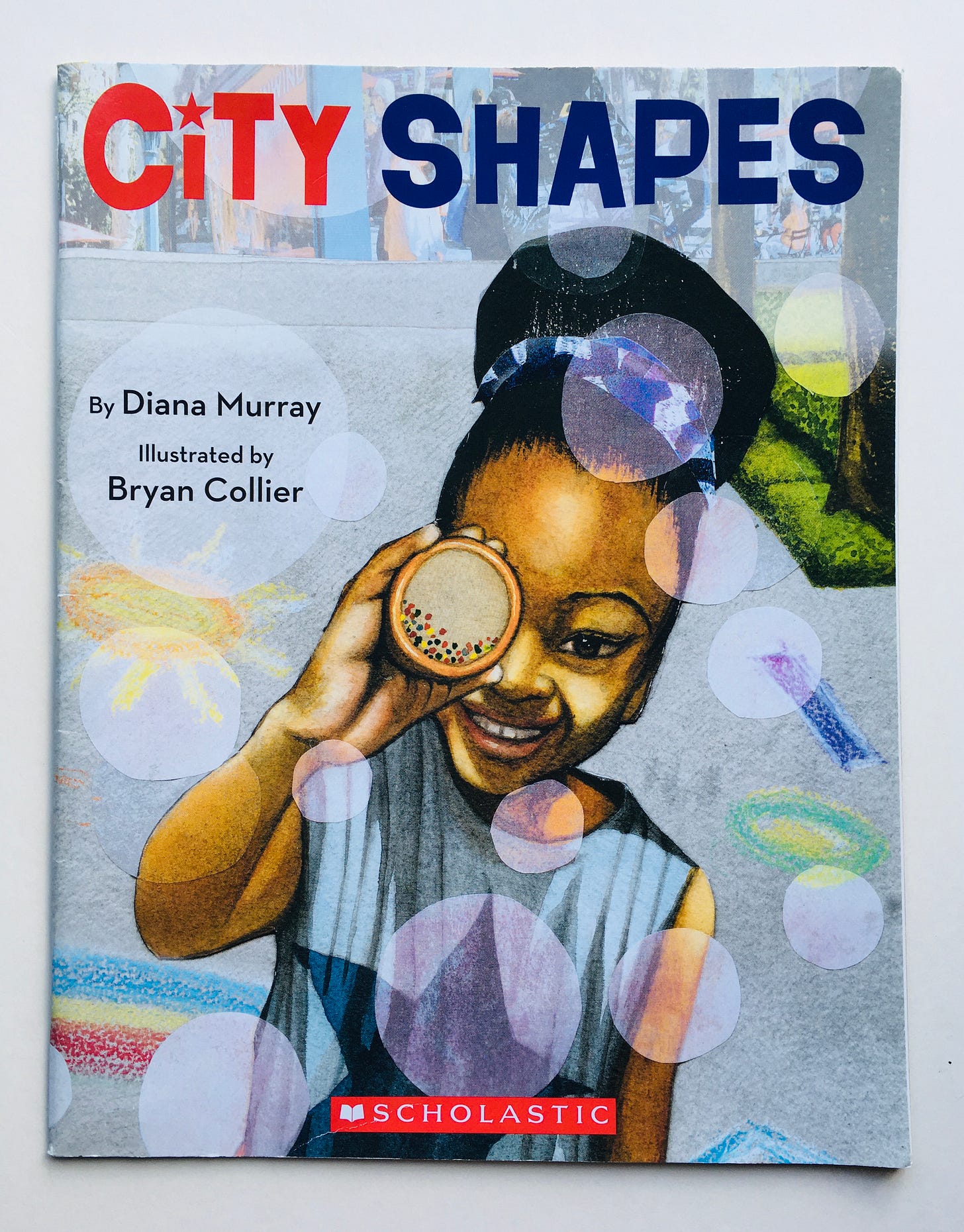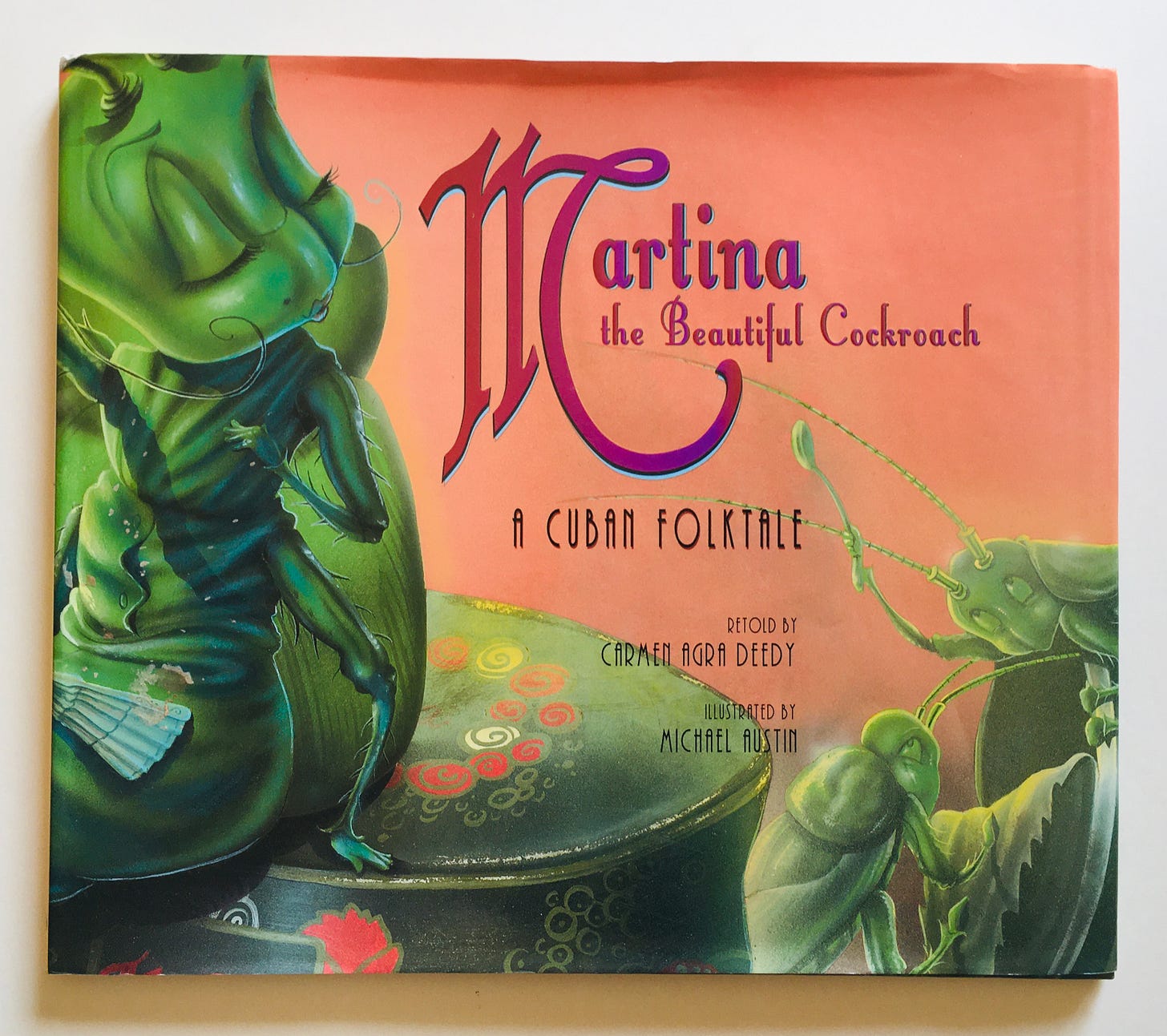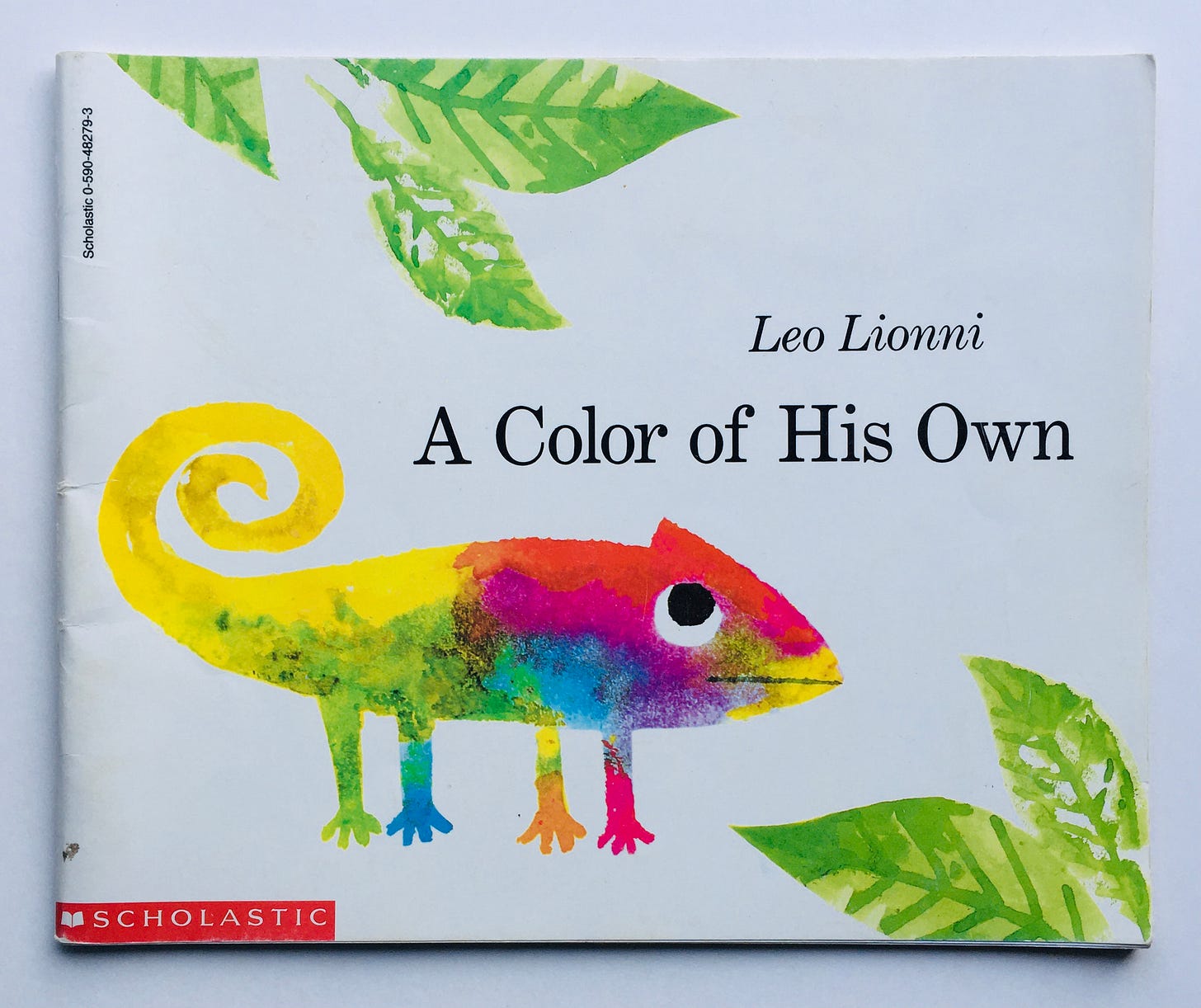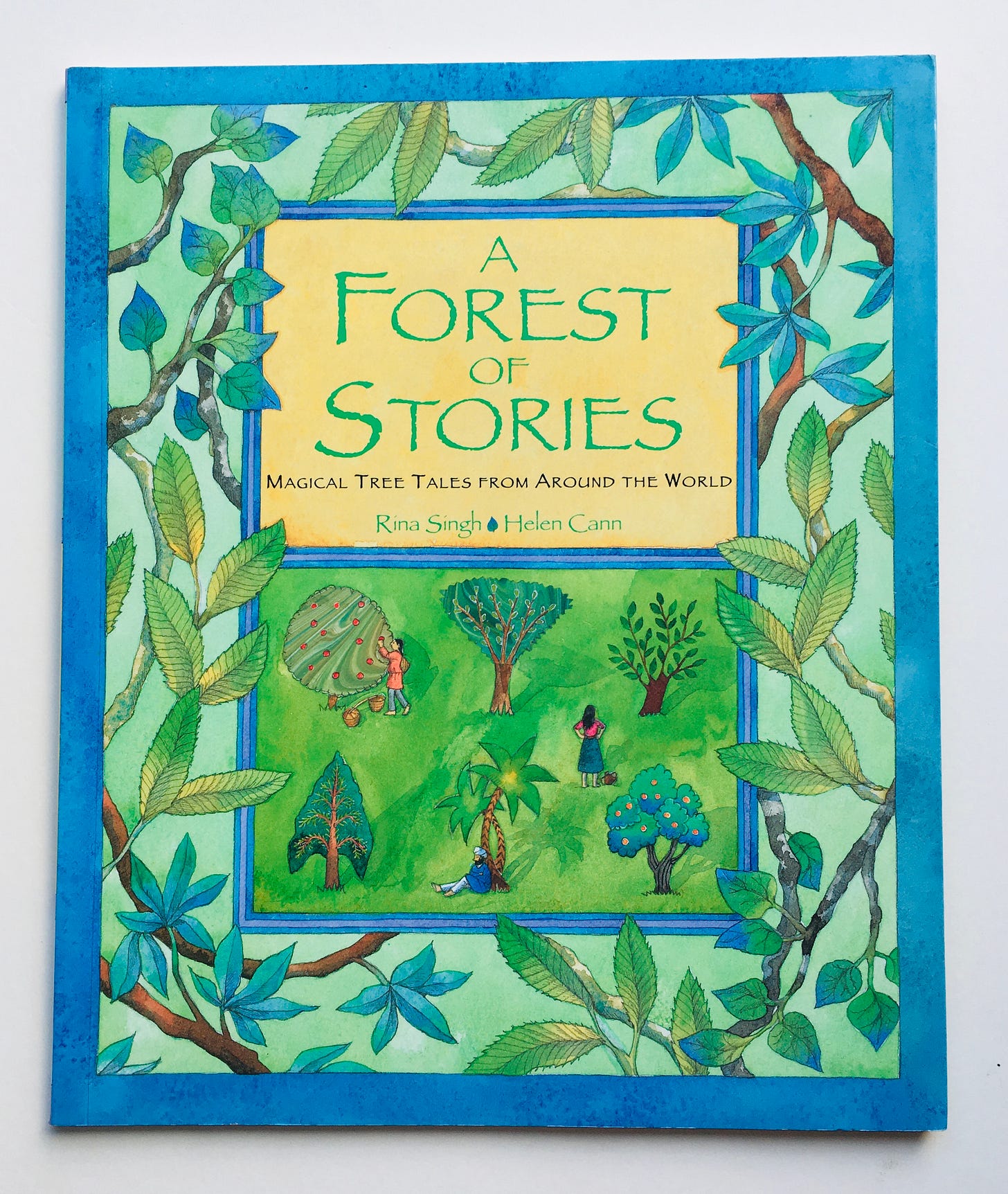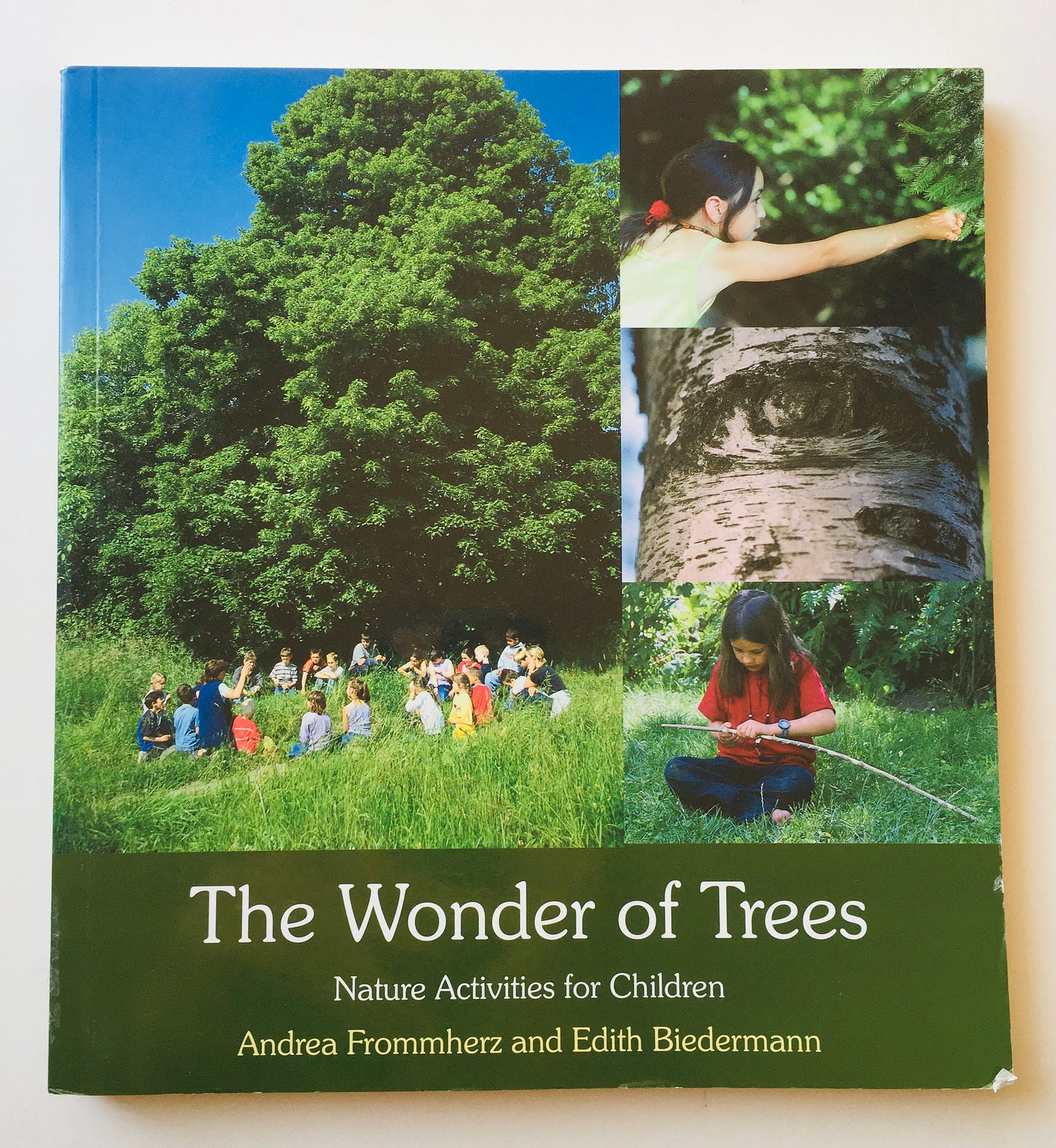Shapes, cockroaches 🪳, chameleons and trees
Can we read? No. 54
(100% I just wanted to use the cockroach emoji.)
Good morning! I hope this issue finds you safe, healthy, and well.
With only 11 days until Halloween left, it’s not too late to read some spooky books with your kiddos. ICYMI, check out my 2021 special edition on Halloween (which is free for all subscribers and anyone else, too, so go ahead and share it with someone who might like it!)
Now for more books, always.
City Shapes by Diana Murray, illustrated by Bryan Collier (2016)
Less a narrative and more a rhyming visual adventure around a big city — with a special emphasis on all the shapes to be found — this creative and colorful title is an excellent living math book, especially for little ones still learning to identify the basics.
Murray’s text flows well and her focus on all the shapes to be found in a vibrant and lively city feels utterly natural: “a silvery cart with hot pretzels for sale” is a square, “the seaport with all of its flowing white sails, and there in the market, the pointy fish tails” are triangles, “the wheels of the taxis that zip down the street” are, of course, circles. I suppose this could be any number of cities — it’s never explicitly stated — but it feels like NYC to me, with its vast array of architectural and cultural wonders and its bright buzzing energy.
Collier captures this spirit with wonderful accuracy, with watercolor and collage illustrations full of things to look at, find, and discuss — this would be a great one to get for toddlers, especially if you live in or travel to a big city (or maybe especially if you don’t — this is a first-rate counterpoint to books about living the country, or farm life). I like this one for its uncommon lens, which offers, at the very least, a different way to notice — and appreciate — the world in which we live.
Martina the Beautiful Cockroach: A Cuban Folktale by Carmen Agra Deedy, illustrated by Michael Austin (2007)
I am rarely, if ever, a fan of the “let’s put all your dinky female-brained focus on getting married” narrative so when I first started to read this to my children I was skeptical and wondered if it would be one of those books I’d immediately need to get rid of, but this clever, quirky tale surprised me (and anyway my children fell in love with it so if I had needed to disappear it I’m not sure I could have done so with any success).
Here the reader meets Martina Josephina Catalina Cucaracha, who lives “in a cozy streetlamp in Old Havana with her big, lovable family.” Now that she’s 21 days old she is “ready to give her leg in marriage” (okay, this made me laugh), and every señora in her family is eager to help, especially her abuela, who gives her the strange advice that in order to find a good husband she must spill coffee on each suitor’s shoes. “It will make him angry!” her grandmother says, “Then you’ll know how he will speak to you when he loses his temper.” (Shockingly good advice whether you’re a cockroach or a human.)
So, as each suitor visits, Martina does just that — and each suitor, of course, gets mad and shows who he truly is. Don Gallo, the rooster, has a cocky reaction; Don Cerdo, the pig, too boorish; Don Lagarto, the lizard, too cold-blooded. It’s only when Martina is approached by Pérez the mouse, a tiny creature who had been right under nose (literally, in the basket below her streetlamp) the whole time, that she finds a man kind enough — with a clever Cuban grandmother of his own — to marry.
This is an incredibly appealing, fun story full of the idea that the most important part of marriage is finding someone who will treat you with respect and love and challenge you to be your best self — a message I can absolutely get behind. Matched with Austin’s lush, attention-grabbing acrylic illustrations, this book is something truly special. We’ve read this over and over and over — I’m so glad I didn’t disappear it.
A Color of His Own by Leo Lionni (1975)
In 17 months of reviewing books every single week, I’ve never covered one by Leo Lionni — not because I don’t like them or think they’re worth reading or sharing (I do; Cornelius is my favorite), but because most of Lionni’s books are well-known and well-loved, as they should be, and so I didn’t want to spend my time or yours nudging you towards them.
But.
Sometimes a popular title is worth the reminder, and certainly most (if not all) esteemed children’s authors have earned their places in the pantheon, Lionni included. (I once read an entire book about how one little girl in a classroom connected with a handful of his titles — The Girl With the Brown Crayon: How Children Use Stories to Shape Their Lives by Vivian Gussin Paley, a veteran preschool/kindergarten teacher and early childhood education researcher whose books helped me understand my own children, and the importance of storytelling and fantasy play in their lives, better than anything else I’ve ever read. But I digress.)
In this title a little chameleon notices that “all animals have a color of their own” — which leads him to wonder and worry, why doesn’t he? Chameleons, of course, change color, “on lemons,” “on heather,” “on tigers.” So he decides to remain on a leaf forever, in order to have a color of his own, but that doesn’t work — fall arrives and with it, red leaves and, naturally, a red chameleon. In spring, he meets another chameleon. He laments his predicament but the other chameleon — who is older and wiser — invites the little chameleon to stay together and change together, which is exactly what they do. (In the right frame of mind, this gesture brings tears to my eyes for its tenderness, for the raw need that a good, true friend can meet.)
Don’t we all wonder, sometimes, exactly who we are? Lionni handles deep questions of self-identity — and the answer in the form of acceptance and friendship — in a way that children (and their grownups ✋) can not only understand but take real comfort from.
A Forest of Stories: Magical Tree Tales From Around the World retold by Rina Singh, illustrated by Helen Cann (2003)
In the introduction to this book, Singh writes,
Trees are the oldest living things on earth. They were here long before man appeared on this planet. They live for centuries and some are known to date back two thousand years or more. They are, in a sense, our living ancestors.
Trees are also here with us now. We have a direct relationship with them — an unfair alliance, in which we accept a multitude of gifts from them and offer nothing in return.
In this book, Singh has made an effort to repay all that trees do for us by highlighting the special place trees have held in world folklore. Her seven stories not only offer an international portrait of trees from various diverse places and cultures — the cypress from China, the kapok from Guatemala, the chestnut from Japan, the cherry blossom from India, the palm from Nigeria, the fig from Poland, and the pomegranate from Morocco — but a celebration of the mystery and magic of trees.
Cann’s evocative watercolor, graphite, and collage illustrations are lovely but not necessary — one could read this collection aloud without sharing the images and still reap the benefits of the beauty within. This is a unique book that helps open the eyes of both children and adults to the trees — those age-old, far-sighted mystical beings — all around us, and all over the earth.
The Wonder of Trees: Nature Activities for Children by Andrea Frommherz and Edith Biedermann (2012)
I know that I write positively about every book in this newsletter — my purpose here is to share with you books I think are worth reading, not to offer a neutral review — but it’s hard for me to convey how much I love this title (which pairs beautifully with A Forest of Stories, above).
Part nature guide, part craft and activity manual (part engrossing read for grownups!), this unique book focuses on 13 trees — apple, birch, beech, oak, ash, spruce, hazel, hedge rose, elder, chestnut, lime (linden), walnut, and willow — and ways to notice, interact with, and love them through all four seasons.
No two sections are exactly the same — some include sensory activities, craft projects using parts of the tree (fairy wands made from ash branches), a short story (a fairy tale that features that particular tree), even tiny recipes (for simple things like tea, or body care products, e.g., spruce oil), all of which are not only fun for children ages 2-10 but frankly kind of fascinating. (I originally bought this book for myself, if that gives you any idea of its value, but have found it a useful and unique guide to exploring the outdoors all year round with my children — I don’t read it aloud, per se, but rather, pull from it when I need some inspiration.)
If you are already enchanted by the ancient secrets, magic, and wisdom held within trees then you will love this book as much as I do, and if you have yet to discover those delights, this will draw you in. Either way, this rather unusual book is remarkable and contains much to delight your children and you.
Thanks for reading today!
Sarah



